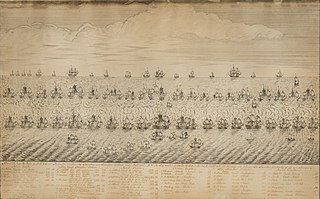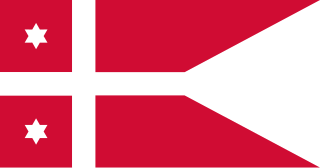
General admiral or Admiral general was first a Dutch then Danish, German, Russian, Portuguese, Spanish and Swedish naval rank. Its historic origin is a title high military or naval dignitaries of early modern Europe sometimes held, for example the (nominal) commander-in-chief of the Dutch Republic's navy.
Søehesten was an 18-gun barge of the Royal Dano-Norwegian Navy, commissioned in 1795. During the Battle of Copenhagen on 2 April 1801, it was commanded by Lieutenant B. U. Middelboe with a complement of 178 sailors. 12 of the ship's crew were killed in the battle, and 21 wounded. The ship struck its colours at 14.30.

Vice-Admiral Jens Schou Fabricius was a Norwegian naval officer who served as Minister of the Navy from 1817 to 1818. He served as a representative for Søe-Deffensionen at the Norwegian Constitutional Assembly at Eidsvoll in 1814. During his naval career he served first the Danish-Norwegian Crown until the separation in 1814 of Norway and Denmark, and thereafter the Norwegian-Swedish Crown. Fabricius retired from the navy as a vice admiral.
The Admiral Danish Fleet (ADMDANFLT) was the operationally supreme organisation of the Royal Danish Navy between 1 January 1991 and 30 September 2014.

Frederik Christian Kaas was a Danish naval officer and landowner. He served as the governor of the Royal Danish Naval Academy from 1770 to 1781.
The name of Steen Andersen Bille is closely associated with one extended Bille family of Danish naval officers over several generations.

Battle of Rügen was a major naval battle fought on August 8, 1715 off Jasmund on the Swedish island of Rügen during the Great Northern War.

HDMS Elephanten was a ship of the line of the Royal Dano-Norwegian Navy that served from 1703 to 1728. There were three other Danish ships-of-the line of the same name, dating from 1684, 1741 and 1773. The ship was sometimes referred to as Nye Elefant to differentiate from others of similar name. For much of her service career, which coincided with the Great Northern War, Elephanten was the flagship of the Danish fleet active in the Baltic Sea.

The Secretary of War was from 1688 the administrative leader of the military in Denmark-Norway. In 1736, it was divided into separate offices for the Army and the Navy and was dissolved as part of Johann Friedrich Struensee's administrative reforms in 1770.

The Chief of the Royal Danish Navy is the professional head of the Royal Danish Navy.
HDMS Friderichsværn was a Danish frigate built at Nyeholm, Copenhagen, in 1783. The British Royal Navy captured her in 1807 and took her into service as HMS Frederickscoarn. It sold her in 1814.
Admiral Henrik Lorentz Fisker was a Danish naval officer and politician. He was the son of an attorney at the supreme court, and deputy mayor of Copenhagen. From the age of thirteen as a cadet in the Danish-Norwegian navy, he rose through the ranks to vice admiral in 1775 and full admiral in 1790. He died 20 June 1797 and was buried in the Holmens Kirkegård, the Danish naval cemetery, in Copenhagen.
HDMS Ørnen (1694) was a frigate in the Royal Danish Navy active during the Great Northern War
Vice-Admiral Olfert Fasvier Fischer was a Royal Dano-Norwegian Navy officer. In addition to serving in the navy, he also became a director of the Danish Asia Company and ended his career as a vice admiral.

The Naval Blockade of Reval was a blockade of the Russian fleet in the harbour of Reval in the summer of 1726 by a joint force of British and Danish ships.
HDMS Nidelven was a brig launched at Copenhagen on 1 December 1792. She was present at both British attacks on Copenhagen, and the British Royal Navy seized her at Copenhagen on 7 September 1807 at the surrender of Copenhagen. The British took her into service as HMS Nid Elven. She served between 1808 and 1809, during which time she captured a small French privateer. She was laid up in 1809. The Navy sold her in 1814.

HDMS Justitia was a 72-gun ship of the line of the Royal Dano-Norwegian Navy built to a design by Henrik Gerner. Although launched in 1777, she was not fully commissioned until 1780. The Royal Navy captured her together with most of the Dano-Norwegian navy after the battle of Copenhagen in 1807. The British never commissioned Justitia. A renaming to Orford in 1809 was cancelled. She was broken up in 1817.

HDMS Justitia was a ship-of-the-line designed by Ole Judichaer built at Nyholm, Copenhagen for the Royal Danish-Norwegian Navy.
















